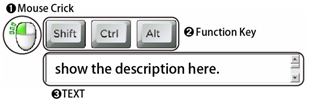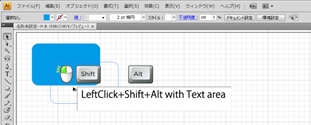Introduction
Our university is only for visually impaired and hearing impaired students. In the lecture class for hearing impaired students, we use several methods with sign language. They are projecting Power Point file or captured image to the screen, writing some experiments to the white board, and playing subtitled video materials, etc[1][2]. These methods are useful for the hearing impaired students and produce some educational effects in the lecture. However, even using these methods, it is difficult to teach how to operate graphical designing software like Adobe Illustrator or Photoshop. We prepared many video materials and e-learning system to teach such kind of software though, some of students could not comprehend how to use the designing software. We think the reason why is that showing real time operation to the students is needed in such lectures. Showing real time operation is quite effective to the “hearing students” in the normal case, because we use oral explanation in the same time. On the other hand, hearing impaired students cannot hear such oral information. Even though there is sign language translator or subtitling service to the real time operation, the hearing impaired students cannot see both of them simultaneously. Addition to it, these translation services has slight delay in general.
Synchronized Key points Indication Tool
To solve the problem mentioned above, we developed support software named “Synchronized Key points Indication Tool :SZKIT”[3] [4] [5] [6]. The overview of the software is shown in Figure 1. The software is composed of several icons and an instruction text area. The mouse icon appears when the teacher clicks mouse button and the key icons appear when he/she presses real keyboard. The figure shows most of icons to explain how it looks like, but they are hided at first and appear just after teacher’s actions and gradually disappear. About instruction text area, it is a space for showing text to explain how to operate the designing software. Basically the instruction texts should be prepared in advance by the teacher and he/she can control a changing timing by using hotkey. Figure 2 shows how SZKIT works in the real situation. In that case, teacher is drugging a mouse with pressing Alt- key and Shift-key. Hearing impaired students can understand what kind of operation is done in real time with these icons and they can also get text information without moving visual axis. The SZKIT is already used in the practical lecture in our university.

Figure 1. Interface of SZKIT

Figure 2. Look of teaching with SZKIT
Evaluation of SZKIT
To clear the effect of the SZKIT, experimental lecture sessions of Adobe Illustrator were conducted. We prepared two types of lecture which has different difficulty level, easy one and hard one. Both lectures have two sessions each, which is conducted with SZKIT and without it. Therefore the number of conditions of the experimental lecture was four. To avoid effect of order, these four conditions are shuffled. After these experimental lectures, students answered several questionnaires which estimate effects of getting information. The number of hearing impaired students was 11, but validate number is 10 because one person knew examination contents in advance.
Two types of tasks were performed in 8 minutes. Both tasks were scored on 100-point scale. We compared tasks. Whether there is a difference between the two tasks, we performed t-test. As a result, statistically significant was observed.
References
[1] MURAKAMI Hiroshi, MINAGAWA Hiroki, Multimedia education system for hearing impaired students, IEIC Technical Report (Institute of Electronics, Information and Communication Engineers), vol.100, 2001, p.143-148
[2] TOKUNAGA Satoru, FUJITA Miyu, ASANO Satoshi, OKAMOTO Akira, Research on the information design through the works of creating educational Contents for auditory handicapped people, The Institute of Electronics, Information and Communication Engineers, Well-being Information Technology 101(73), 2002, p.13-18
[3] KOBAYASHI Makoto, SUZUKI Takuya, WAKATSUKI Daisuke, Teaching Support Software for Hearing Impaired Students Who Study Computer Operation - SynchroniZed Key Points Indication Tool: SZKIT. ICCHP (1) 2012, p.10-17
[4] SUZUKI Takuya, Research on Design Practice Support Intended for Hearing Impaired Students, Tsukuba University of Technology Techno Report Vol.18(2), 2011, p.68-72
[5] KOBAYASHI Makoto, SUZUKI Takuya, Support Software which Instructs Hearing Impaired Students of Computer Operation - SZKIT: SynchroniZed Key points Indication Tool -,Tsukuba University of Technology Techno Report Vol.18(2), 2011, p.35-39
[6] SUZUKI Takuya, WAKATSUKI Daisuke, KOBAYASHI Makoto, Support Software which Instructs Computer Operation for Hearing Impaired Students: SZKIT, Human Interface Society, 2011.
[7] SUZUKI Takuya, WAKATSUKI Daisuke, KOBAYASHI Makoto, Evaluation of Support Software which Instructs Computer Operation to Hearing Impaired Students, The Institute of Electronics, Information and Communication Engineers, TECHNICAL REPORT OF IEICE 111(472), 2012, p.33-38